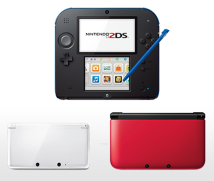1. Shigesato Itoi Tries Nintendo 3DS
Editor's Note: Shigesato Itoi is a Japanese copywriter, author and game designer. He is most well known for his simple yet striking works in copywriting, and his works have greatly influenced modern Japanese culture as it is known today. His website "Hobo Nikkan Itoi Shinbun" (Almost Daily Itoi News) receives over 1.5 million page views per day, and hosts a series of interviews with many cultural icons including Satoru Iwata and Shigeru Miyamoto of Nintendo. Among gaming enthusiasts in the West he is most well known as the creator of Nintendo's Mother series (known as EarthBound in the United States).
First of all, I’d like to have Itoi-san look at a demonstration of the Nintendo 3DS. We exhibited this at the Electronic Entertainment Expo1 in June 2010. These images are for showing how images on Nintendo 3DS look three-dimensional without the use of special glasses. 1Electronic Entertainment Expo (E3): A video game-related trade show usually held in Los Angeles.
Okay.
What’s showing now is a stereoscopic display of a video of natural imagery taken with two cameras.
Uh-huh, uh-huh…
And next are graphics of Nintendo characters generated in real time in the Nintendo 3DS system. This is the Circle Pad . You can change the camera angle with it.
Oh, wow! It’s more interesting this way!

When it moves, it’s totally different, right?
Yeah, absolutely.
The Nintendo 3DS has a slide switch called the 3D depth slider . On the side there. Moving it up and down changes the 3D volume.
3D volume… Oh! Wow, like this!
You can adjust for yourself how three-dimensional you want the images to appear.
It’s the concept of 3D volume. Is this something that most devices with 3D elements have?
No, I don’t think there are any other examples of 3D devices doing this. This was the result of the ideas of multiple people, including Miyamoto-san, during the process of developing Nintendo 3DS.
I see… So up until now, the 3D volume has generally been decided by the makers of the images.
Exactly so. The makers of the images say, “Let’s do it about this much.” But each player will have his or her own comfort zone when it comes to the depth of stereoscopy.
Yeah, right.
What’s more, even the same person will desire differing depth of stereoscopy depending on the situation, and think things like, “I want it to be more three-dimensional here,” or “Now I want it flat.” So we thought we would make Nintendo 3DS so players can choose the depth of stereoscopy, and what’s more, instinctively and easily adjust it to each situation.
And that’s called the 3D depth slider.
Right. We were very particular about having the switch be a slide. We thought it was very important that it be intuitive. Digital input - raising or lowering numbers - wouldn’t convey it at all.
Oh right, I see.
We made it so players can adjust according to how it feels to them, like “Right now I want it somewhere around here” and “Here I want to go all out!”

Can you also adjust the three-dimensionality of the video of natural imagery we saw earlier?
No, you can’t change the three-dimensionality of something recorded beforehand. You can turn the stereoscopic display on or off, though. In other words, you can only select whether you want it to look three-dimensional or not.
The images for games are rendered in real time within the console, so adjusting the degree of stereoscopy is possible.
Even for 3D movies, the images are all fixed ahead of time, so you can’t do this.
I see… Do you mind if I turn the three-dimensionality way down?
Go ahead.
Ahh…mm-hmm, mm-hmm… It isn’t very interesting when it’s flat.
Exactly.
Hmm, it really isn’t! That wasn’t quite what I expected. To be honest, I thought it would be just fine either way.
Yeah. (laughs)
I mean, until now, we’ve taken something two-dimensional but represented it in a three-dimensional way and augmented it in our imagination.
Right, right. We made it three-dimensional in our heads.
Yeah. I didn’t think that power of imagination was anything to sniff at. That isn’t exactly wrong, but when you see this…well, it’s much more pleasing. How should I put it? The 3D you imagine and actual three-dimensionality are different.

With 3D graphics up until now, you felt a sense of depth when the camera swung around.
In other words, the movement makes it feel three-dimensional. But this is three-dimensional the moment you see it.
Right. When you actually see it in three dimensions, you’re surprised by how much it changes.
Um, you know how you showed me a little bit of the demo a little while back? This looks better than that did. Is that because you improved the hardware? Or am I just looking at it differently?
Actually, it hasn’t changed at all since I had you try it out before.
So it’s my own internal problem.
Yeah. (laughs)
I must have been resisting it before.
Yeah. (laughs)
I was surprised then, but… How should I put this? Maybe I adopted a slightly judgmental attitude when faced with something new, like “Let’s see how good this is or not.”
Oh, did you?
Yeah. I was really surprised before, but this time I’m more delighted, more excited - like it’s really jumping out at me.
A lot of people who try it out say, “I can really see it!” We’re trying to come out with that kind of product, so if that’s all that impresses people, we’re in trouble! (laughs) But on the other hand, it seems like lots of people who have tried 3D devices up until now haven’t really had a clear experience to make them think, “It really looks three-dimensional!” With this, as a result, lots of people’s first impression is “I can really see it!”

You can’t help but say it. Like “You don’t need special glasses!”
Yeah, lots of people say that, too. (laughs)
Well…you know…this is really… Oh, that’s Pikmin!2 Great! 2Pikmin: A game released for the Nintendo GameCube system in June 2002 in Europe and the name of a type of creature that appears in the games of the series.
Doesn’t Pikmin look great? (laughs)
It seems like Pikmin is perfect for 3D.
I like the way they scurry around.
Pikmin is a game with a peculiar 3D effect as if you’re getting down on hands and knees to look at something small. Man, I want one of these! I’ll buy one, Mr President! How much is it going to cost me, Mr President ?
(laughs) Well, shall we close the Nintendo 3DS system and begin our conversation?
Oh, right. Please.
Go ahead.
Actually, today I wanted to propose a certain topic.
Oh? I wonder what it could be…
It’s something I haven’t even told Miyamoto-san yet.
What is it?! (laughs)
